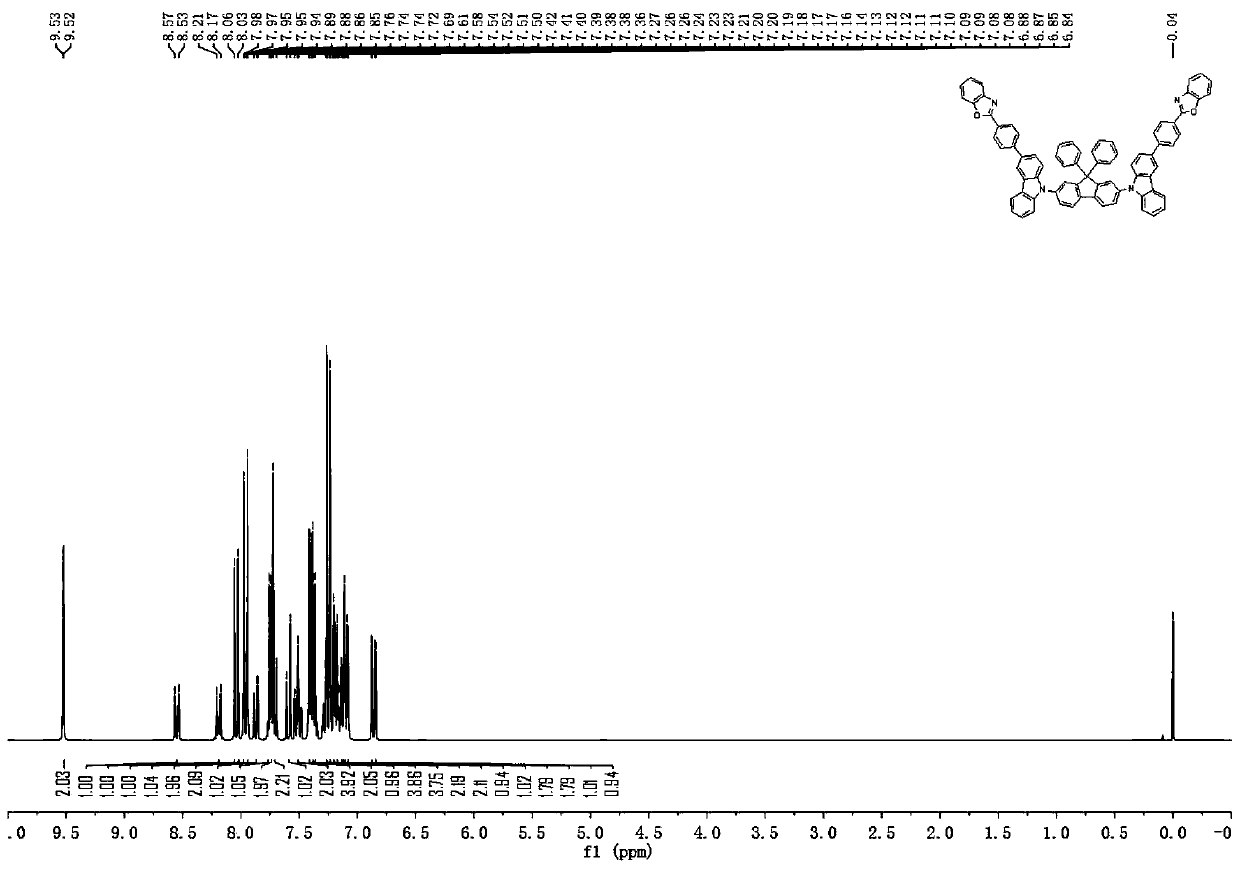Heterocyclic compound and organic electroluminescent device thereof
A heterocyclic compound and electroluminescence technology, which is applied in the materials of organic semiconductor devices, electric solid devices, organic chemistry, etc., can solve the problem that the refractive index is only about 1.90, and can increase the glass transition temperature and improve the transmittance. , The effect of improving the light output efficiency
- Summary
- Abstract
- Description
- Claims
- Application Information
AI Technical Summary
Problems solved by technology
Method used
Image
Examples
preparation example Construction
[0066] The preparation method of the heterocyclic compound of the present invention can be prepared by a conventional coupling reaction, for example, it can be prepared by the following synthetic route, but the present invention is not limited thereto:
[0067]
[0068] Compound (a) reacts with compound (b) by Suzuki to obtain intermediate (A), or compound (a) reacts with compound (c) by Suzuki to obtain intermediate (B), or compound (d) and compound (e ) through the Buchwald reaction to obtain the intermediate (C); the intermediate (A), (B) or (C) reacts with the halide (f) Br-L-Br or I-L-Br containing the L group again, Finally, the target compound shown in formula (I) is obtained.
[0069] Among them, the L, L 1 , X, R 1 The definitions of , m, and n are as described above, and will not be repeated here.
[0070] In the present invention, there is no special limitation on the reaction conditions of the above reactions, and the reaction conditions well known to those s...
Embodiment 1
[0105] Embodiment 1: the preparation of compound 9
[0106]
[0107] Under nitrogen protection, compound a-1 (4.89g, 30mmol), compound b-1 (7.46g, 30.3mmol), K 2 CO 3 (12.44g, 90mmol), stirred with 300mL of toluene solvent. Add catalyst Pd(PPh 3 ) 4 (0.35g, 0.3mmol), 50mL of distilled water, the temperature was raised to reflux, and the reaction was stirred for 10h. After fully reacting, 75 mL of distilled water was added to terminate the reaction. The crude intermediate A-1 was obtained by filtration under reduced pressure, washed three times with distilled water, and then recrystallized with toluene and ethanol (10:1) to obtain 6.65 g of the target compound A-1 with a yield of 78%.
[0108] Under argon atmosphere, dissolve intermediate A-1 (5.74g, 20.2mmol), f-1 (3.12g, 10mmol), sodium tert-butoxide (2.40g, 25mmol) in 100ml dehydrated toluene, and add palladium acetate under stirring (0.04g, 0.2mmol), a toluene solution of tri-tert-butylphosphine (0.16g, 0.8mmol), a...
Embodiment 2
[0110] Embodiment 2: the preparation of compound 12
[0111]
[0112] Bromide b-1 was replaced by bromide b-2 in an equimolar amount, and other steps were the same as in Example 1 to obtain compound 12. Mass Spectrum m / z: 818.39 (calculated: 818.27). Theoretical element content (%)C 58 h 34 N 4 o 2 : C, 85.07; H, 4.18; N, 6.84; O, 3.91. Measured element content (%): C, 85.14; H, 4.21; N, 6.89; O, 3.90. The above results confirmed that the obtained product was the target product.
PUM
| Property | Measurement | Unit |
|---|---|---|
| Thickness | aaaaa | aaaaa |
Abstract
Description
Claims
Application Information
 Login to View More
Login to View More - R&D
- Intellectual Property
- Life Sciences
- Materials
- Tech Scout
- Unparalleled Data Quality
- Higher Quality Content
- 60% Fewer Hallucinations
Browse by: Latest US Patents, China's latest patents, Technical Efficacy Thesaurus, Application Domain, Technology Topic, Popular Technical Reports.
© 2025 PatSnap. All rights reserved.Legal|Privacy policy|Modern Slavery Act Transparency Statement|Sitemap|About US| Contact US: help@patsnap.com



